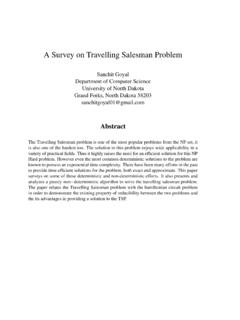Transcription of Phase Transitions in Combinatorial Optimization …
1 ArXiv:cond-mat/0602129v1 [ ] 6 Feb 2006 Phase Transitions inCombinatorial OptimizationProblemsAlexander K. Hartmann and Martin WeigtWILEY-VCH Verlag GmbH & Co. KGaAFebruary 3, 20083 Introduction to graphsThe next three sections give a short introduction to graph theory and graph algorithms. Thefirst one deals with the basic definitions and concepts, and introduces some graph second one is dedicated to some fundamental graph algorithms. In the third one, we willdiscuss random graphs, which will be of fundamental importance throughout this us begin by mentioning some books related to graph theory. All of them go well beyondeverything we will need concerning graphs: Gary Chartrand,Introductory graph theory, Dover Publ.
2 Inc., New York, little paperback contains a nice, easy-to-read introduction to graph theory. Everychapter is based on real-world examples, which are mappedto graph problems. It is agood book for everyone who wishes to know more about graphs without working througha difficult mathematical book. B la Bollob s,Modern graph Theory, Springer, New York by one of the leading graph theorists, this book covers the first and third section(and much more). It is very good and complete, but mathematically quite difficult. Robert Sedgewick,Algorithms in C: graph Algorithms, Addison Wesley, Boston book collects many graph algorithms, including extensive descriptions and proofsof their Basic concepts and graph The bridges of K nigsberg and Eulerian graphsThe earliest use of graph theoretical methods probably goesback to the 18th century.
3 At thistime, there were seven bridges crossing the river Pregel in the town of K nigsberg. The folkshad long amused themselves with the following problem: Is itpossible to walk through thetown using every bridge just once, and returning home at the end? The problem was solvedby Leonhardt Euler (1707 1783) in 1736 by mapping it to a graph problem and solving it forarbitrary graphs [1], i. e., for arbitrary towns, city maps,etc. In the case of K nigsberg, he hadto draw the slightly disappointing consequence that no suchround-walk Transitions in Combinatorial Optimization K. Hartmann and Martin WeigtCopyrightc 2005 Wiley-VCH Verlag GmbH & Co. KGaA, WeinheimISBN: 3-527-40473-2263 Introduction to graphsFigure shows the river Pregel, K nigsberg was situated on both sides and both islands.
4 Theseven bridges are also shown. The mapping to a graph is given below. Every river side, islandand bridge is assigned avertex, drawn as a circle, two vertices are connected by anedge, drawnas a line, if they are also physically connected. To give a more precise description, we haveto introduce the basic graph -theoretical terminology which is summarized in the :The bridges of K nigsberg and its graph representation. Vertices are denoted bycircles, edges by definitions: An( undirected ) graphG= (V, E)is given by itsverticesi Vand its undirectededges{i, j} E V(2). Note that both{i, j}and{j, i}denote the same edge. TheorderN=|V|counts the number of vertices. ThesizeM=|E|counts the number of edges. Two verticesi, j Vareadjacent / neighboringif{i, j} E.
5 The edge{i, j}isincidentto its end Basic concepts and graph problems27 Thedegreedeg(i)of vertexiequals the number of adjacent vertices. Vertices of zerodegree are calledisolated. A graphG = (V , E )is asubgraphofGifV V, E E. A graphG = (V , E )is aninduced subgraphofGifV VandE =E (V )(2),i. e.,E contains all edges fromEconnecting two vertices inV . A subgraphG = (V , E )is apathofGif it has the formV ={i0, i1, .. , il},E ={{i0, i1},{i1, i2}, .. ,{il 1, il}}. Thelengthof the path isl=|E |.i0andilare calledend points. The path goes fromi0toiland vice versa. One saysi0andilare connected by the path. Note that, within a path, each vertex (possibly except for theend points) is visited only once.
6 A path withi0=il, i. e., aclosed path, is called acycle. A sequence of edges{i0, i1},{i1, i2}, .. ,{il 1, il}is called awalk. Within a walksome vertices or edges may occur several times. A walk with pairwise distinct edges is called atrail. Hence a trail is also a subgraph ofG. Acircuitis trail with coinciding end points, i. e., aclosedtrail. (NB: cycles are circuits,but not vice versa, because a circuit may pass through several times through the samevertex). The graphGisconnectedif all pairsi, jof vertices are connected by paths. The graphG = (V , E )is aconnected componentofGif it is a connected, inducedsubgraph ofG, and there are no edges inEconnecting vertices ofV with those inV\V . Thecomplement graphGC= (V, EC)has edge setEC=V(2)\E={{i, j}|{i, j}/ E}.
7 It is thus obtained fromGby connecting all vertex pairs by an edge, which are notadjacent inGand disconnecting all vertex pairs, which are adjacent inG. Aweighted graphG= (V, E, )is a graph with edge weights :E : GraphsWe consider the graph shown in Fig. It can be written asG= (V, E)withV={A, B, C, D, a, b, c, d, e, f, g}E={{A, a},{A, f},{A, d},{A, f},{A, g},{B, a},{B, b},{B, c},{C, e},{C, f},{C, g},{D, c},{D, d},{D, e},}.Hence, the graphs has|V|= 11vertices and|E|= 14edges. Since{D, e} E,the verticesDanddare adjacent. Vertexdhas degree deg(d) = 2, while vertexAhas degree example,G = (V , E )withV ={A, g, C, e, D}andE ={{A, g},{g, C},{C, e},{e, D},}is a path connected, because all vertices are con-nected by paths to all other vertices.
8 The sequence of edges{B, c},{c, D},{D, c}283 Introduction to graphsis a walk, but it does not correspond to a path, because some vertices are visitedtwice. The sequence of edges{A, b},{b, B},{B, a},{a, A},{A, g},{g, C},{C, f},{f, A}is a trail, in particular it is a back to the problem of the people from K nigsberg, formulated in graph -theoreticallanguage, they were confronted with the following question:EULERIAN CIRCUIT:Given a graph , is there a circuit using everyedgeexactly once?The amazing point about Euler s proof is the following: The existence of a Eulerian circuit which obviously is a global object can be decided looking topurely local properties, in thiscase to the vertex :A connected graphG= (V, E)is Eulerian (has an Eulerian cycle) iff all vertexdegrees are :( )This direction is trivial.
9 Following the Eulerian circuit,every vertex which is entered isalso left, every time using previously unvisited edges. Alldegrees are consequently even.( )The other direction is a bit harder. We will proof it by induction on the graph sizeM, forarbitrary graphs having only even vertex theorem is obviously true forM= 0(one isolated vertex) andM= 3(triangle) whichare the simplest graphs with even we take anyM >0, and we assume the theorem to be true for all graphs of size smallerthanM. We will show that the theorem is also true for a connected graphGof sizeMhavingonly even ofM >0, the graphGis non-trivial, because of the even degrees it contains verticesof degree at least 2. ThenGcontains a cycle, which can be seen in the following way: Startin any vertex and walk along edges.
10 Whenever you enter a new vertex, there is at least oneunused edge which you can use to exit the vertex again. At a certain moment you enter avertex already seen (at most afterMsteps), the part of the walk starting there is a cycle is also a circuit. Consider now a circuitC= (G , E )of maximal size|E |. IfCis a Eulerian circuit inG, everything is OK. If not, we have|E |<|E|, and the subgraphH= (V, E\E )has at least one non-trivial connected componentH . A circuit has evendegrees, thusHand all its connected components have even degrees. SinceH has size< M,it has an Eulerian circuit which can be added toC, violating the maximality ofC. Thus,Chas to be an Eulerian circuit, and the proof is back to K nigsberg, we see that there are vertices of odd degrees.
![arXiv:0706.3639v1 [cs.AI] 25 Jun 2007](/cache/preview/4/1/3/9/3/1/4/b/thumb-4139314b93ef86b7b4c2d05ebcc88e46.jpg)

![arXiv:1301.3781v3 [cs.CL] 7 Sep 2013](/cache/preview/4/d/5/0/4/3/4/0/thumb-4d504340120163c0bdf3f4678d8d217f.jpg)
![@google.com arXiv:1609.03499v2 [cs.SD] 19 Sep 2016](/cache/preview/c/3/4/9/4/6/9/b/thumb-c349469b499107d21e221f2ac908f8b2.jpg)








